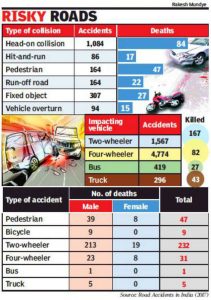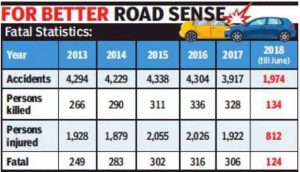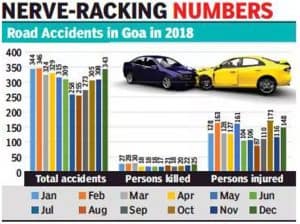Road safety is of prime importance as road accidents are among the biggest causes of deaths in the country,
with the number of vehicles on our roads increasing with every passing hour.
One of the most common complaints from commuters and locals is that the roads in Goa are always suffering
from some kind of damage during the monsoons.
There have been minor and major accidents including fatal ones due to bad road conditions.
In view of this and many such issues that need resolving, Act For Goa in a collaborative effort with Nine Stack, a Goa-based application development firm,
have pooled our technical skills, love of Goa and on ground sustainable development knowledge and outreach,
to create an app that supports and encourages people’s participation in sustainable progress and rural/urban planning in the state.
Pinit
~This innovative sustainability app will allow anyone who cares about Goa to map the issues that need resolving,
as well as cherished places and organisations which work to keep Goa clean and Green~
Download the app HERE
Watch the app tutorial here
—
Press recognitions
—
The app is designed to help concerned citizens from all across the state understand land usage, identify places, organizations, or professionals that can help them and their community,
as well as crowd source data on issues that need to be fixed at the community level.
It can also help villages in their village development planning.
Pinit enables residents from across Goa to take action on subjects they care about and crowdsource data
– from pothole ridden roads and garbage black spots, to heritage sites, recyclers and water bodies,
Pinit enables everyone to participate in keeping Goa clean green and uniquely Goan.
—
Goa based technology firm Nine Stack with a client based in Europe worked along with Act for Goa to design and build the app.
Act for Goa and Nine Stack have a shared vision for Goa which involves greater participation of the community
in mapping and planning the spaces they live in.
The PinIt app empowers every citizen to play an active role in this process.
The company builds cloud-based apps and offers technology-based solutions to meet the business needs of corporate entities.
—
To tie in this effort, Act for Goa is collaborating with Cecille Rodrigues’ #Rosto Campaign,
an initiative that identifies unmarked speed breakers and cautions commuters about blind spots, highlights the pothole menace,
a subject which dominates social discourse especially during the monsoons.
Cecille will be embarking on a campaign to get citizens to ‘’pin’ potholes and traffic hazards in their locality onto the app.
—
#Rosto: Not on a screen on your mobile device but on the road
Dancer, Zumba instructor and former AAP candidate Cecille Rodrigues has been moving around the state and identifying speed breakers that can be threatening to riders and drivers,
bringing the count of speed breakers she has painted so far to 300 with her #rostogoa team.
Soon, Rodrigues started documenting deteriorating the state of road in small videos, hoping for a discussion.

After she released her hit song, ‘Rosto’ back in September 2019, the reaction from the audience motivated her to take the #Rosto campaign to the next level.
Cecille Rodrigues’ song ‘Rosto’ parodies the insanely popular Bebdo by singing sensation Lorna, but with a wicked twist, and is all about the deplorable condition of the roads in Goa,
emphasising mainly on the pothole-ridden streets.
The video features friends and family singing and dancing in and around the potholes, insinuating that one can swim in them, fish in them, and apparently, even drink tea from them!
She’s even interspersed the video with newspaper cutouts and other viral videos.
—
Cecille Rodrigues, Seema Chimulkar and Prakash Malani have developed unique road stamp ‘Rosto’ which cautions drivers of blind spots, thus reducing accidents on the road.
The idea of painting speed breakers struck Cecille after a bad experience on a speed breaker.
“I got the idea of painting the speed breaker when I was driving in the night. I have a metal plate in my back because of an accident on a speed breaker during my college days, and recently, I hit my back again while driving in the dark and I didn’t notice the speed breaker. I thought of painting the speed breaker so that others don’t go through the same experience.
My first speed breaker painting was in Calangute,” reveals Cecille.
While earlier they just painted the speed breaker stripes, now they leave their #Rosto signage. “People should know it’s a people’s movement. Everyone is welcome to paint and reclaim.” said Rodrigues.
Cops of the state too who have passed by them have given them the thumbs up, while furthermore, a couple helped the #Rosto team on ground.
The biggest challenge for them is to distinguish the illegal speed breakers from the authorised ones. By law, speed breakers are supposed to be marked, have reflectors, have signboards, have street lights, and sometimes all four things are missing.
Faulty road engineering, improper signage and poor road conditions threaten the lives of motorists in the state, especially at 18 accident-black spots analysed by Confederation of Indian Industry – Young Indians and Goa Institute of Management (GIM).
Road Accidents in India (2017) report have revealed that 232 of the 328 people killed in road accidents in Goa were two-wheeler riders.

According to 2018 data, as many as 264 lives were lost in 183 road accidents in Goa, out of which 67 were self-accidents.
A slew of Covid-induced restrictions resulted in fewer people venturing out of their homes, consequently bringing down road accident deaths in Goa roughly by one quarter during the first eight months of 2020. Earlier, the state would witness one such casualty every day on an average.
Government statistics indicate that a total of 1,522road accidents were reported in the state till August this year. The same period in 2019 saw as many as 2,286 accidents.
“Last year, fatal accidents amounted to 178 while this number dropped to 138 till August this year,” a senior police officer said.
“Till August, 145 people lost their lives in accidents while 191 died last year.”
—
Road engineering continues to be one of the common causes of accidents in Goa. With the kind of roads Goa has, the problems vary from place to place.
These include bad roads and improper asphalting to lack of central divider and no speed bump markings.
However, traffic discrepancies have been a major source of death, injury and damage to property every year. In 2018, over-speeding of vehicles was the main reason for road accident casualties.
(source: https://timesofindia.indiatimes.com/)
—
Reasons for unsafe roads
Goa’s infrastructure is not adequate to handle the traffic flow of the state. A ride on the highways will reveal it.
Certain points are bottleneck for the traffic. They are an impediment for the smooth flow of the vehicles.
Authorities – Responsible for maintaining the infrastructure and facilities.
They usually suffer from lack of manpower or lack of will to implement the rules.
It is alleged that many indulge in corruption.
Whatever the reasons, they are accountable for keeping the roads safe.
Public – As much as authorities are responsible, people equally share the responsibility.
There are many instances of people breaking the basic traffic rule of wearing a helmet.
Eventually it boils down to how concerned the public is towards road safety.
If everyone takes the initiative to be careful on the roads, the amount of road accidents will come down.
Evidence clearly indicates that it is not the sole responsibility of the authorities to ensure road safety.
Active participation of the public will go a long way.
Genuine situations can lead to an accident.
Caution can prevent a road accident.
Road Safety Resources – important links
Department of Transport – Govt. of Goa
Ministry of Road Transport and Highways
Road Safety Rules in India – Road Safety Tips
—
Act for Goa is committed to working along with the local panchayat bodies, state authorities, bureaucracy, community leaders, and concerned citizens to map the various issues and assets in regions across Goa.








